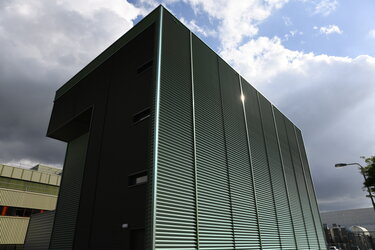Accept all cookies Accept only essential cookies See our Cookie Notice

About ESA
The European Space Agency (ESA) is Europe’s gateway to space. Its mission is to shape the development of Europe’s space capability and ensure that investment in space continues to deliver benefits to the citizens of Europe and the world.
Highlights
ESA - United space in Europe
This is ESA ESA facts Member States & Cooperating States Funding Director General Top management For Member State Delegations European vision European Space Policy ESA & EU Space Councils Responsibility & Sustainability Annual Report Calendar of meetings Corporate newsEstablishments & sites
ESA Headquarters ESA ESTEC ESA ESOC ESA ESRIN ESA EAC ESA ESAC Europe's Spaceport ESA ESEC ESA ECSAT Brussels Office Washington OfficeWorking with ESA
Business with ESA ESA Commercialisation Gateway Law at ESA Careers Cyber resilience at ESA IT at ESA Newsroom Partnerships Merchandising Licence Education Open Space Innovation Platform Integrity and Reporting Administrative Tribunal Health and SafetyMore about ESA
History ESA Historical Archives Exhibitions Publications Art & Culture ESA Merchandise Kids Diversity ESA Brand CentreLatest
Space in Member States
Find out more about space activities in our 23 Member States, and understand how ESA works together with their national agencies, institutions and organisations.
Science & Exploration
Exploring our Solar System and unlocking the secrets of the Universe
Go to topicAstronauts
Missions
Juice Euclid Webb Solar Orbiter BepiColombo Gaia ExoMars Cheops Exoplanet missions More missionsActivities
International Space Station Orion service module Gateway Concordia Caves & Pangaea BenefitsLatest
Space Safety
Protecting life and infrastructure on Earth and in orbit
Go to topicAsteroids
Asteroids and Planetary Defence Asteroid danger explained Flyeye telescope: asteroid detection Hera mission: asteroid deflection Near-Earth Object Coordination CentreSpace junk
About space debris Space debris by the numbers Space Environment Report In space refuelling, refurbishing and removingSafety from space
Clean Space ecodesign Zero Debris Technologies Space for Earth Supporting Sustainable DevelopmentLatest
Applications
Using space to benefit citizens and meet future challenges on Earth
Go to topicObserving the Earth
Observing the Earth Future EO Copernicus Meteorology Space for our climate Satellite missionsCommercialisation
ESA Commercialisation Gateway Open Space Innovation Platform Business Incubation ESA Space SolutionsLatest
Enabling & Support
Making space accessible and developing the technologies for the future
Go to topicBuilding missions
Space Engineering and Technology Test centre Laboratories Concurrent Design Facility Preparing for the future Shaping the Future Discovery and Preparation Advanced Concepts TeamSpace transportation
Space Transportation Ariane Vega Space Rider Future space transportation Boost! Europe's Spaceport Launches from Europe's Spaceport from 2012Latest

Six-degree-of-freedom microvibration machine
Thank you for liking
You have already liked this page, you can only like it once!
The latest addition to ESA’s satellite-testing facilities is this six-degree-of-freedom microvibration unit, sufficiently sensitive to identify the multi-axis forces induced by a single dropped feather.
Most satellites have some limits on microvibration to ensure high-quality results, especially for science, Earth observation and human spaceflight. Minimising jitter helps to deliver ultra-high-resolution images, precision attitude control and pointing stability for optimal science measurements.
Many essential satellite elements are potential sources of jitter, such as spinning reaction wheels, scanning or pointing mechanisms, solar array drives or rotating cryocoolers.
Developed for ESA by the UK’s National Physical Laboratory – a national centre of excellence for measurement standards – this new microvibration test machine is designed to characterise extremely small disturbances from satellite subsystems or to assess the performance of precision mechanisms.
In addition, it is able to generate a controlled microvibration environment by itself, allowing the assessment of an item’s performance under various conditions.
“In recent years we’ve built a portfolio of world-class microvibration test facilities with demonstrated, unprecedented performance,” comments Mark Wagner, ESA’s Head of Test Facilities and Test Methods.
“This new facility is complementing these capabilities, enabling us to offer an independent characterisation of potential microvibration sources while also allowing performance testing of sensitive equipment while subjected to an injected microvibration environment."
Standing around a metre high, the facility – being installed at the ESTEC Test Centre in Noordwijk, the Netherlands – performs two tasks at once.
Its bottom section isolates the rest of the measurement part of the machine from vibrations transferred via the ground such as nearby footsteps, seismic noise or even the waves of the nearby North Sea. Suitably detached in this way, the top section measures micronewton-scale forces and torques from the item under test.
The unit operates under a plastic tent to minimise perturbations from airflow caused by the building’s cleanroom-class air conditioning. It can also work in vacuum.
Once it is qualified, it will enter service in June. ESA is also looking for a permanent name for the machine – watch this space for more details.
ESA Test Centre
Designed for full-scale satellite testing, the ESTEC Test Centre is a collection of facilities to simulate every aspect of the space environment.
Everything is located under a single roof, within a controlled cleanroom environment tailored for delicate flight hardware.
Based in a dedicated building in ESTEC, it is the largest centre of its kind in Europe, and one of the largest in the world.
-
CREDIT
ESA–G. Porter -
LICENCE
ESA Standard Licence

Briefing on microvibration machine

Solar array drive mechanism on microvibration unit

Expanding ESTEC’s Test Centre

ESA’s Test Centre expands















 Germany
Germany
 Austria
Austria
 Belgium
Belgium
 Denmark
Denmark
 Spain
Spain
 Estonia
Estonia
 Finland
Finland
 France
France
 Greece
Greece
 Hungary
Hungary
 Ireland
Ireland
 Italy
Italy
 Luxembourg
Luxembourg
 Norway
Norway
 The Netherlands
The Netherlands
 Poland
Poland
 Portugal
Portugal
 Czechia
Czechia
 Romania
Romania
 United Kingdom
United Kingdom
 Slovenia
Slovenia
 Sweden
Sweden
 Switzerland
Switzerland

























